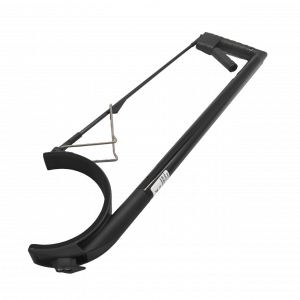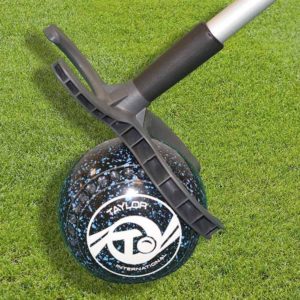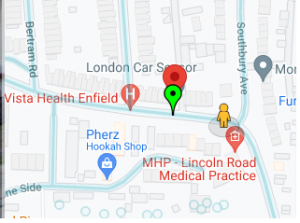Bowling Aids
What did the bowler say to the golfer?
Ask a golfer to play a round without sticks and you’ll get a very funny look. Ask a bowler to bowl *with* sticks, and the look will be even funnier. Everybody knows that golfers can’t play without sticks and bowlers can’t play with them …. unless they have a disability.
Not so says Nick Atkins. This Australian entrepreneur is on a one-man crusade to encourage all bowlers, arthritic *and* able-bodied, to use his company’s Hunter Hacksaw bowling arm to improve their game.
Nick points out – and not a lot of people know this – that the use of bowling aids by anyone is not prohibited by the Laws of Bowls. Neither does he understand why in the UK, people would rather be seen …. well, would rather not be seen at all using a ‘bowling aid’ due to their close association with disabilities of all kinds.
“That’s crazy” he tells me. “Why wouldn’t you use a product that is almost certain to improve your delivery line and eliminate delivery bounce?”
Bowling Aids
He has a point. Let’s face it, most bowlers already do. Whether it’s a damp cloth, a tube of Grippo or a tub of Winwax, just about everyone you know is already using a bowling aid. It’s just that none of us who use these products think of ourselves as ‘disabled’. The same applies to the ubiquitous ‘lifter’ a staple for thousands of bowlers with a bit of back, knee or hip trouble who would never for a moment consider applying to the Council for a blue badge.
There’s also an increasingly popular evolution of the lifter called the Bowlsmate. This adjustable height stick combines the lifter with a ferrule and an ergonomic handle so the bowler can lean forward on it while delivering to provide support and stability.
I suggest to him that, sad as it may be, there is a stigma associated with products perceived as “disability aids” or “enabling products” amongst the able-bodied fraternity which no amount of persuasion will overcome. Try and tell a Grippo user they’re using a bowling aid and they’ll tell you where to stick it – and it won’t be on your bowls!
Grip, gloves and cloths
Grip is the most ubiquitous bowling aid, and comes in many varieties. Wilgrip is a small tube of white paste for applying to your fingers. Grippo and Betts are similar products supplied for application to the surface of the bowls. The formulation of these products are closely guarded trade secrets. They may look like toothpaste, but I promise you toothpaste doesn’t do the trick. Apply an inch of ‘bowlspaste’ to your bowl, smear around the surface with a cloth, wait for 10 to 20 seconds then buff to a shine.
It’s counter-intuitive of course. You would expect a smooth shiny surface to be very slippery, but the magic of these pastes is that as you polish, they become stickier.
Bulldog is a block of waxy blue squidgy material which you apply to your fingers – but not to the bowl. Then there are three branded cloths impregnated with wax – Aero Gorilla, Taylor Grippit and Drakes Pride Get-A-Grip. Keep a square of any of these in your pocket and squeeze it between your fingers between deliveries
Monkey Grip and Winwax are tubs of a carnauba-based formulation that can be applied to bowls or fingers …. or both. Carnauba wax is a natural wax derived from the leaves of the carnauba palm tree (Copernicia prunifera), which is native to northeastern Brazil. It is sometimes referred to as the “queen of waxes” due to its hardness, high melting point, and glossy finish. Those in the know swear that these two products are the best to use when the rain is pouring down. Whereas Grippo, Betts and WIlgrip may only be needed once or twice during an 18-end match, the carnauba-based products should be re-applied during downpours to eliminate any loss of grip.
Some bowlers improve their grip by using a thin leather or simulated leather glove on the bowling hand. Although we stock gloves at Bush Hill Bowls, I don’t like to sell them without examining the patient’s … I mean customer’s motives. Like a pharmacist who doesn’t like to sell powerful painkillers to a customer without asking a few questions I will start by asking what problem they are hoping to solve by wearing a glove.
Can you guess?
So is a glove the answer? In most cases I will advise that it isn’t. And it’s not because there’s more profit selling a set of bowls than selling a glove. But in most cases the bowler hasn’t even considered that their bowls are too big for their hands. This is often the case when a bowler of ten or more years experience has been using the same beloved set for ever, feels wedded to it, and divorce never enters their head.
Until I suggest it.
Sticks and poles to bend my bowls
Bowling arms grasp the bowl firmly in their jaws. For anyone with back or knee issues, whether or not they consider themselves ‘disabled’ a bowling arm has obvious advantages.
Because they are available in different lengths to match the height of the user, there is no need to bend back or knees to pick up or deliver the bowl. There’s even a size to be used from a sedentary position in a wheelchair or rollator. A bowling arm delivers a perfect arc of swing from back to front that doesn’t deviate from the line, whose momentum completely eliminates that annoying but common fault when the human arm swings across the body and compromises the direction of travel.
“It’s not fair” I’ve heard bowlers mutter in friendly, county and even national competitions. “That bowling arm thing gives them an unfair advantage.”
The number of times I’ve suggested that the mutterer uses one for themselves and explained that it’s entirely legal for *any* bowler to use one! “Oh no, I wouldn’t use one – I’m not handicapped.”
Well, I think to myself, you are if they are beating you!
Also available are pushers, also known as launchers. These long poles sit on the bowl with a horseshoe shaped front and allow you to literally push or shove the bowl along the green. These are particularly helpful indoors, when resistance from the carpet is not an issue. Anyone could use one, of course, so a bowler with reduced muscle strength in the wrist or forearm can continue to deliver their bowls accurately and to a length.
Next time: Walkers, Rollators and Wheelchairs








